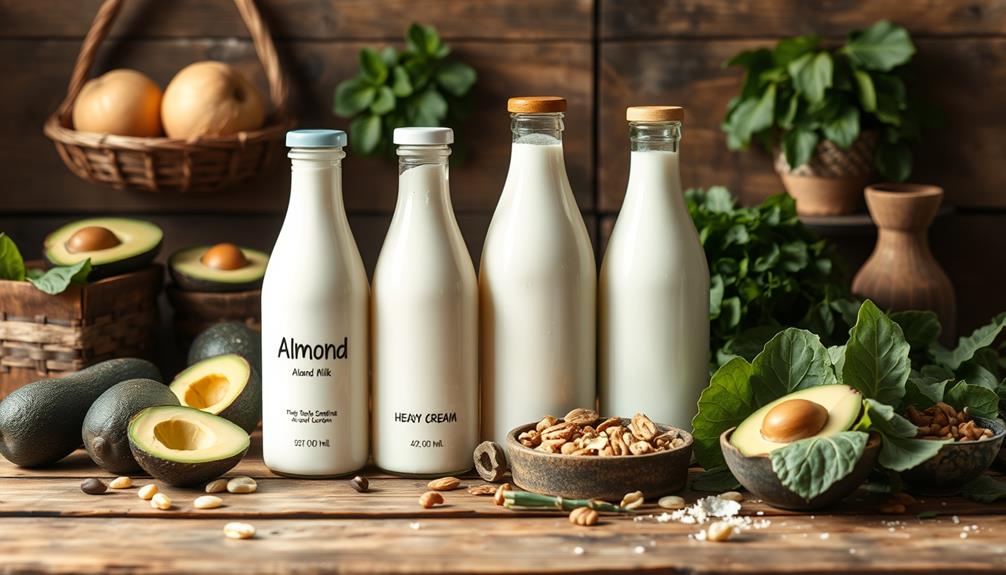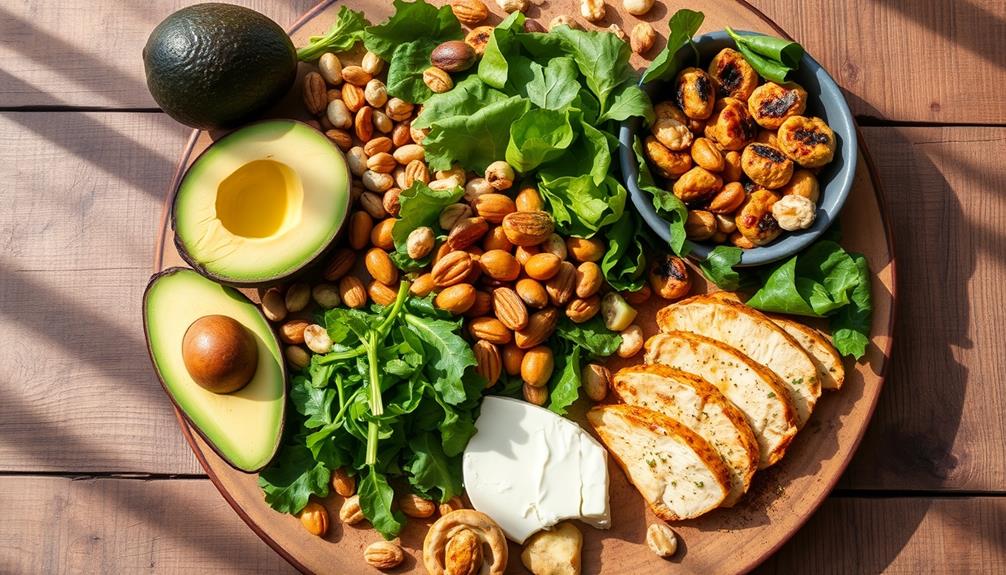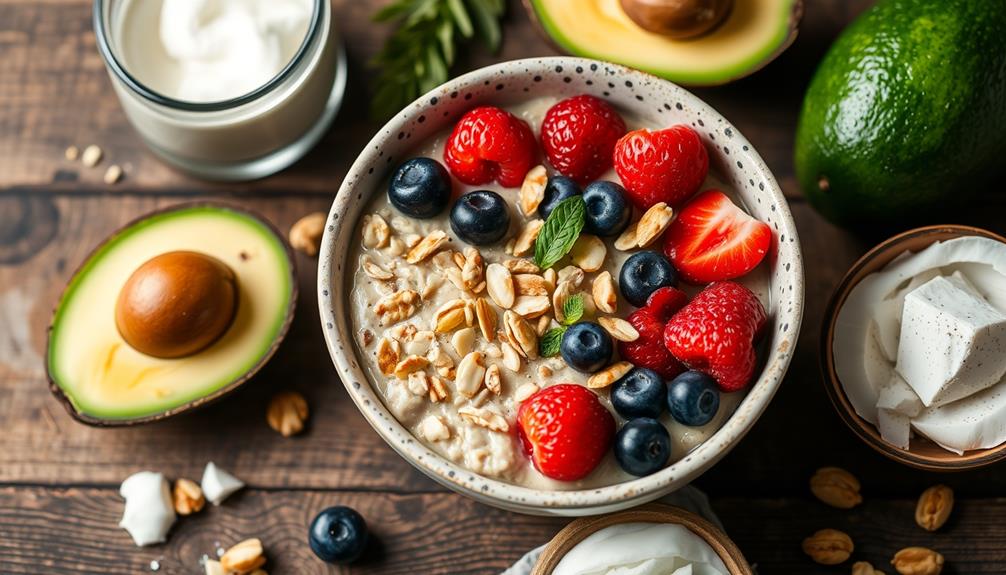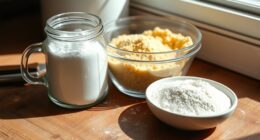When you're on a keto diet, the best milk options help you stay low in carbs while enjoying your meals. Unsweetened almond milk is great, with only 1 gram of net carbs per cup, while macadamia nut milk is even better—zero grams of net carbs! You can also try seed-based choices like flaxseed milk, which has just 1 gram of net carbs. For dairy lovers, heavy cream is low in carbs and high in fat. Always opt for unsweetened varieties to avoid hidden sugars. Discovering the various options will help you make the best choices for your keto journey.
Key Takeaways
- Macadamia nut milk is the best option for keto, containing 0 grams of net carbs per cup.
- Unsweetened almond milk has only 1 gram of net carbs per cup, making it a great low-carb alternative.
- Heavy cream is low in carbs (1 gram per ounce) and high in fat, ideal for cooking and adding creaminess.
- Coconut milk offers about 5 grams of net carbs per cup and provides beneficial medium-chain triglycerides (MCTs).
- Always choose unsweetened varieties to avoid hidden sugars that can spike carb counts and disrupt ketosis.
Overview of the Keto Diet

The ketogenic diet is a low-carb eating plan that shifts your body into a state called ketosis, where it burns fat for fuel instead of glucose. By restricting carbohydrate intake to just 20-50 grams per day, you'll focus on a macronutrient ratio of approximately 70-80% fats, 20-25% protein, and only 5-10% carbohydrates.
This dramatic reduction in carbs encourages your body to utilize ketone bodies for energy, promoting rapid weight loss and various health benefits.
When you start the keto diet, you might experience signs of ketosis, such as fatigue, bad breath, and dry mouth. These symptoms can be monitored with urine ketone testing kits, helping you track your progress. Many individuals notice a weight loss of up to 10 pounds in the first two weeks, thanks to decreased insulin levels and increased fat breakdown.
However, before diving into this low-carb lifestyle, it's important to consult a healthcare provider, especially if you have medical conditions that may lead to high ketone levels.
Embracing the ketogenic diet can be rewarding, but understanding its principles and the role of dairy and milk alternatives is vital to your success.
Importance of Milk Alternatives
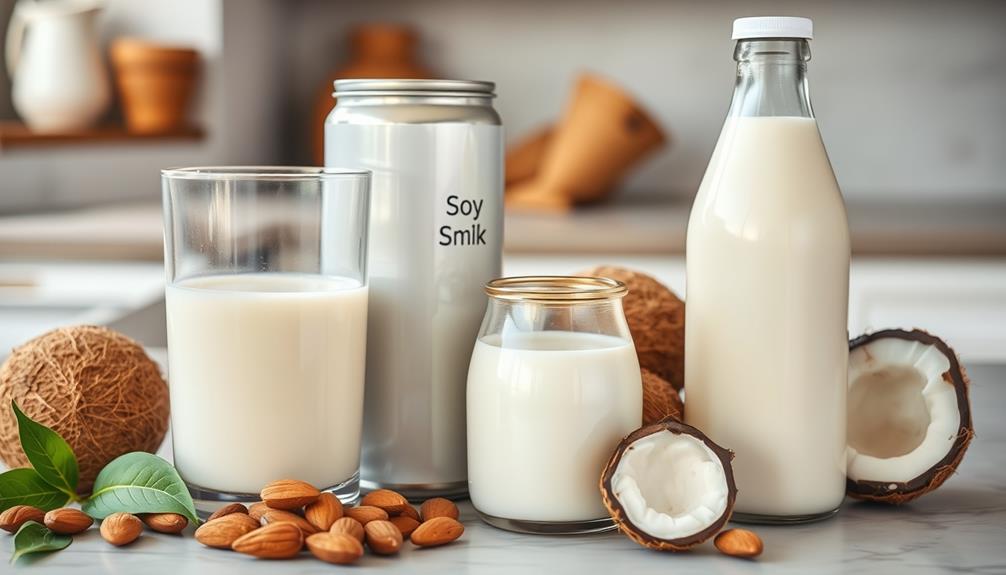
Finding the right milk alternative is essential for anyone on a ketogenic diet. These milk alternatives allow you to enjoy creamy beverages without derailing your low carb goals.
Unsweetened almond milk is a popular choice, boasting just 1 gram of net carbs per cup. It's perfect for coffee, smoothies, or recipes that need a mild flavor.
If you're looking for something even richer, macadamia nut milk is one of the best options, with a remarkable 0 grams of net carbs per cup. This high-fat alternative aligns perfectly with your keto-friendly macronutrient needs.
Coconut milk, while versatile and flavorful, can vary; choose unsweetened varieties to keep net carbs low, ideally around 5 grams per cup.
Seed-based milks, like flax milk, are another great option. They typically contain about 1 gram of net carbs per cup and come packed with omega-3 fatty acids, adding extra nutritional benefits.
Nut-Based Milk Options
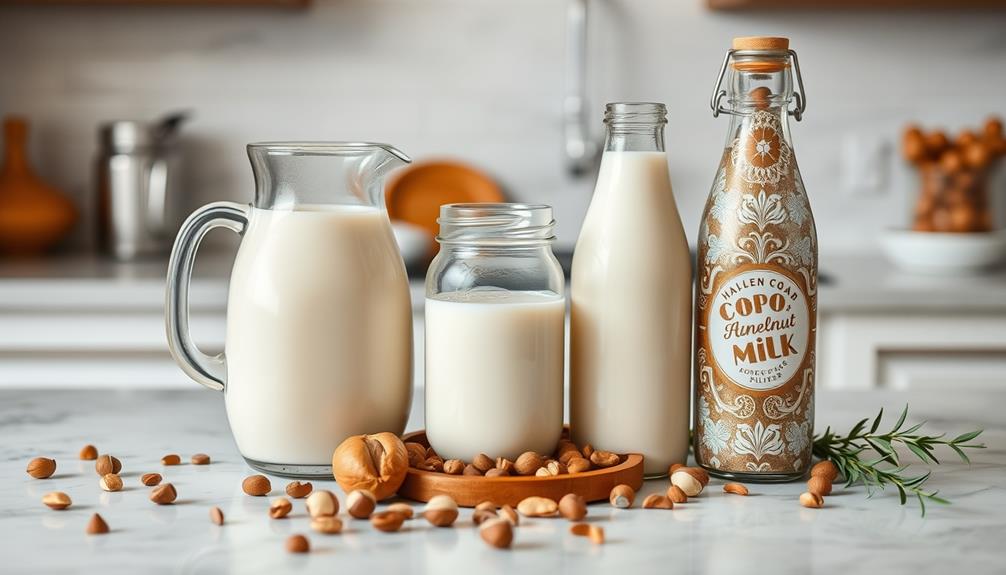
Nut-based milk options aren't only low in carbs but also packed with health benefits that fit perfectly into your keto lifestyle.
You'll find popular choices like almond, cashew, and macadamia milks, each offering unique flavors and nutritional profiles.
Plus, making your own nut milk at home can be simple and rewarding, allowing you to customize it to your taste.
Benefits of Nut Milk
Many people on a keto diet are turning to nut milk for its impressive benefits. Nut-based milks like almond milk and macadamia nut milk are excellent choices due to their low net carbs. With only about 1 gram of net carbs per cup, unsweetened almond milk fits perfectly into your low-carb lifestyle.
Macadamia nut milk takes it a step further, boasting virtually 0 grams of net carbs, making it an ideal option for maintaining ketosis.
Cashew milk offers a creamy texture, containing about 1-2 grams of net carbs per cup, making it versatile for cooking and baking. If you're looking for additional health benefits, flax milk is a great option, as it's not only low in carbs but also high in omega-3 fatty acids, which support overall health and wellness.
Incorporating these nut-based milks into your keto diet can help you enjoy a variety of flavors and textures while keeping your carbohydrate intake in check.
Whether you're sipping it straight, adding it to smoothies, or using it in recipes, nut milk is a fantastic choice for anyone committed to a ketogenic lifestyle.
Popular Nut Milk Types
When it comes to choosing the right nut milk for your keto diet, several popular options stand out. Almond milk is a top choice, offering about 30 calories and less than 1 gram of net carbs per 8 oz. Its unsweetened version makes it a fantastic low-carb option for your daily intake.
Cashew milk follows closely, presenting a creamy texture with around 1-2 grams of net carbs per cup, perfect for cooking and baking—just watch out for added sugars in commercial varieties.
Next, consider macadamia nut milk, which features a high fat content of 3.5 grams and less than 1 gram of net carbs per cup, ideal for maintaining ketosis while enjoying a creamy beverage.
Hazelnut milk, though less common, offers a rich flavor with about 1-2 grams of net carbs per cup, making it suitable for keto recipes and coffee.
Finally, unsweetened pistachio milk is a newer entrant, containing around 1-2 grams of net carbs per cup, adding a unique flavor profile that can elevate various dishes.
Each of these nut milks can fit seamlessly into your keto-friendly lifestyle.
Homemade Nut Milk Recipes
Creating your own nut milk at home isn't only simple but also allows you to control the ingredients and flavor. Start with homemade almond milk by blending 1 cup of soaked raw almonds with 4 cups of water. Strain it through a cheesecloth or nut milk bag for a delicious, low-carb milk option that has about 30 calories and under 1 gram of net carbs per cup.
If you prefer a creamy milk alternative, try cashew milk. Blend 1 cup of soaked cashews with 4 cups of water until smooth, then strain if desired—this yields around 1-2 grams of net carbs per cup.
Macadamia nut milk is another excellent choice; blend 1 cup of nuts with 4 cups of water for a rich option that boasts approximately 0 grams of net carbs.
For a nutritious twist, consider flaxseed milk. Blend 1 cup of flaxseeds with 4 cups of water, resulting in a milk alternative that contains just 1 gram of carbs per cup.
Seed-Based Milk Choices
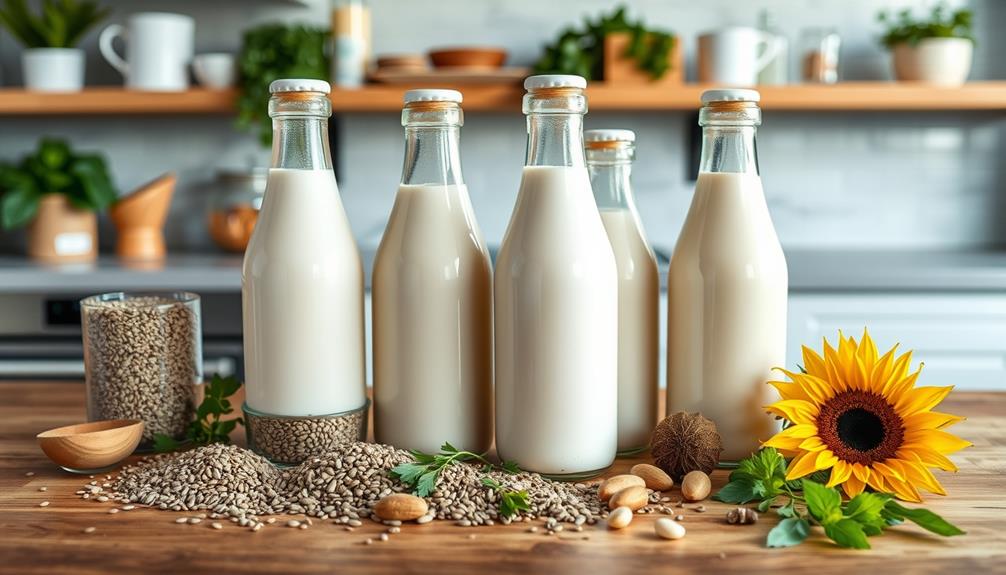
What makes seed-based milk choices so appealing for those on a keto diet? These options provide a low-carb, nutritious alternative to dairy, perfect for keto dieters seeking variety.
Here are three standout choices:
- Flaxseed Milk: With just 1 gram of net carbs per cup, it's rich in omega-3 fatty acids, making it a great addition to your diet.
- Hemp Milk: This creamy texture milk typically offers 1-2 grams of net carbs and is packed with essential fatty acids, perfect for smoothies or coffee.
- Pea Milk: Made from yellow peas, it contains around 2 grams of net carbs and a whopping 8 grams of protein per cup, serving as a high-protein alternative for those with nut or soy allergies.
Other options like Sunflower Seed Milk and Pumpkin Seed Milk also shine, with 2-3 grams of net carbs and impressive nutritional benefits, such as vitamin E and minerals like magnesium and zinc.
Incorporating these seed-based milks into your keto plan can diversify your intake while keeping those carbs in check.
Dairy-Based Milk Alternatives
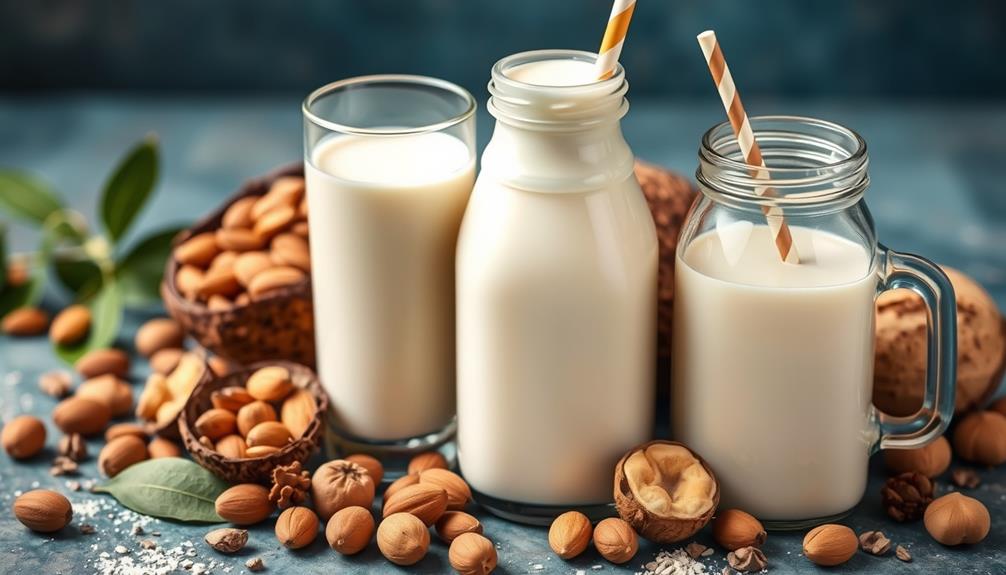
When you're exploring dairy-based milk alternatives, heavy cream and half-and-half are great options to contemplate.
Heavy cream packs a punch with its low carb count and high fat content, making it perfect for cooking and baking.
On the other hand, half-and-half adds a creamy touch to your coffee while still fitting into your keto lifestyle.
Heavy Cream Benefits
Heavy cream stands out as a top choice for those on a keto diet, thanks to its low net carb content and high fat percentage. With just about 1 gram of net carbs per ounce, it's perfect for maintaining ketosis while adding richness to your meals.
Here are three key benefits of using heavy cream:
- High-Fat Content: With a fat content ranging from 36% to 40%, heavy cream is an excellent source of dietary fat essential for your keto lifestyle.
- Versatile Ingredient: You can use heavy cream in a variety of keto-friendly recipes, from savory soups and sauces to indulgent desserts, enhancing flavor without greatly impacting your carb intake.
- Whipped Toppings: It can easily be whipped to create delicious toppings for your favorite keto desserts and beverages, making your treats even more enjoyable.
While heavy cream is low in carbs, it does contain lactose, so if you're lactose intolerant, you'll need to use it cautiously.
In any case, incorporating heavy cream into your diet can elevate your dishes while keeping you aligned with your keto goals.
Half-and-Half Usage
If you're looking for a creamy addition to your keto coffee or recipes, half-and-half can be a great choice. This delightful blend of milk and heavy cream typically contains just 1 gram of net carbs per ounce, making it suitable for your keto diet. Its fat content, ranging from 10.5% to 18%, aligns perfectly with the high-fat requirement of a ketogenic lifestyle.
When you use half-and-half, you can enhance your coffee drinks or add creaminess to various recipes without greatly impacting your daily carb limits. Just be sure to choose unsweetened varieties to avoid any hidden sugars that could raise your carb counts.
If you're seeking a milk-like texture while maintaining a low carb profile, consider diluting half-and-half with water. This method allows you to enjoy a creamier taste while sticking to your keto guidelines.
Whether you're adding it to coffee, soups, or sauces, half-and-half is a versatile option that fits seamlessly into your low-carb diet. Enjoy the richness without the guilt, and make your meals and beverages even more satisfying!
Coconut Milk Benefits
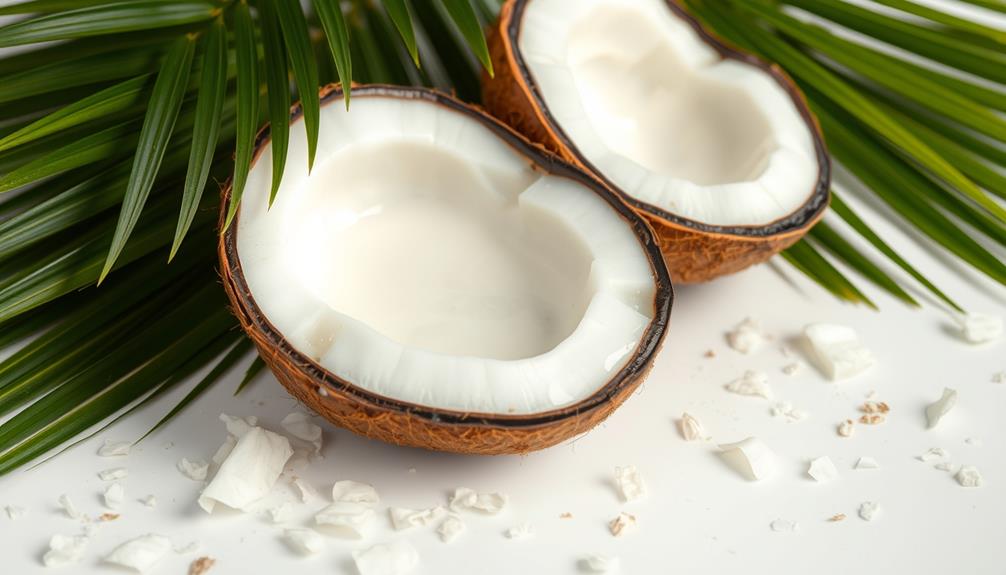
Coconut milk offers numerous benefits for those on a keto diet, making it a fantastic addition to your meal plan. Here are three key advantages:
- Low in Carbohydrates: With some brands containing just 5 grams of net carbs per cup, coconut milk fits perfectly into your low-carb lifestyle.
- High in Healthy Fats: It's packed with medium-chain triglycerides (MCTs), which can enhance fat burning and provide a quick source of energy.
- Rich in Essential Nutrients: Coconut milk contains potassium, magnesium, and vitamin C, supporting your overall health while you stick to keto.
The creamy texture and unique flavor of coconut milk make it a versatile ingredient in your keto recipes. You can use it in smoothies, soups, and curries to elevate your dishes.
For cooking and baking, canned coconut milk is ideal due to its higher fat content, giving your meals that rich, satisfying taste.
Incorporating coconut milk into your diet not only helps you stay within your carb limits but also adds a delightful twist to your meals. Enjoy the benefits of this keto-friendly option!
Sweetened Milk Considerations

While coconut milk is an excellent choice for staying within your carb limits, sweetened milks can quickly derail your keto efforts. When you consume sweetened milks, like chocolate or vanilla varieties, you're often getting high levels of added sugars. These added sugars greatly increase the net carbs, making them unsuitable for your keto diet.
Here's a quick comparison of some common milks:
| Milk Type | Net Carbs (per cup) |
|---|---|
| Sweetened Almond Milk | 7 grams |
| Unsweetened Almond Milk | 1 gram |
| Sweetened Condensed Milk | 165 grams |
| Coconut Milk | 2-3 grams |
It's essential to read labels carefully. Many commercial milk alternatives may contain hidden sugars that elevate their carb counts, impacting your low-carb intake and jeopardizing your efforts in maintaining ketosis. To stay on track, opt for unsweetened options like unsweetened almond milk or coconut milk. These choices align better with your keto goals, helping you enjoy your favorite beverages without the carb overload.
Making the Right Choice
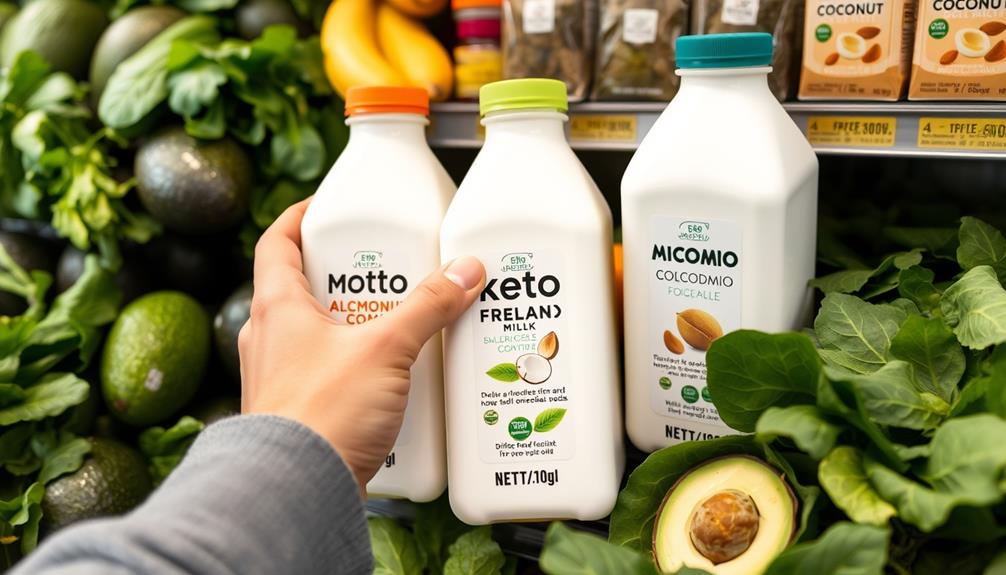
Choosing the right milk for your keto diet can make all the difference in staying within your carb limits. Almond milk and coconut milk are popular choices for those following a keto diet, as they are low in carbs and high in healthy fats. These plant-based milks can be used in a wide variety of recipes and are great options for those looking to incorporate more low carb keto foods into their diet. When choosing a milk for your keto diet, it’s important to read the nutrition label and select an option that is low in carbs and free from added sugars.
Here's what you should keep in mind:
- Opt for Unsweetened Varieties: Always choose unsweetened almond milk or coconut milk to avoid hidden sugars that can add unnecessary net carbs to your diet.
- Consider Low-Carb Dairy Options: Heavy cream and half-and-half are excellent choices, containing around 1g of net carbs per ounce, perfect for keto cooking and baking.
- Explore the Best Alternatives: Macadamia nut milk is the most keto-friendly option, with 0g of net carbs per cup, making it ideal for maintaining ketosis.
Frequently Asked Questions
What Milk Is Best on Keto?
Choosing the right milk depends on your personal taste and dietary needs. Unsweetened almond, macadamia nut, and heavy cream are great options. Just watch for added sugars to stay within your carb limits.
Can I Drink Milk on a Keto Diet?
Did you know whole milk packs about 12 grams of carbs per cup? If you're on a keto diet, it's best to avoid it. Instead, consider options like heavy cream or unsweetened almond milk for low carbs.
What Is a Keto Substitute for Milk?
You can try unsweetened almond milk, macadamia nut milk, or coconut milk as keto substitutes for regular milk. Heavy cream also works well, offering low carbs and high fats to support your ketogenic goals.
Is Oat Milk Keto-Friendly?
Picture a serene landscape, yet oat milk's high carb content disrupts the tranquility of your keto journey. It isn't keto-friendly, so choose wisely—stick to lower-carb options like almond or macadamia nut milk instead.
Conclusion
Choosing the right milk for your keto diet can feel like a quest for the Holy Grail. By exploring nut, seed, and dairy alternatives, you can find options that fit your low-carb lifestyle. Remember to watch out for added sugars, too! With so many delicious choices, you'll easily find the perfect fit for your meals. So go ahead, release your creativity in the kitchen, and enjoy your journey to keto success!
